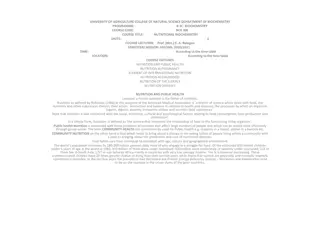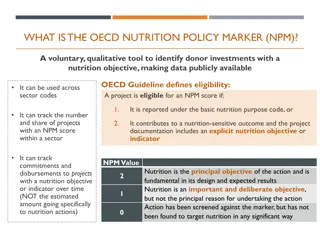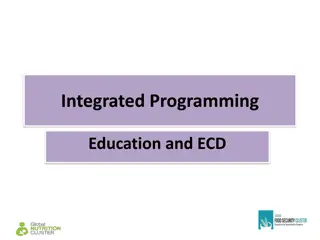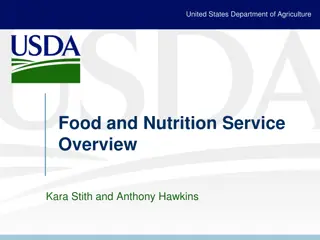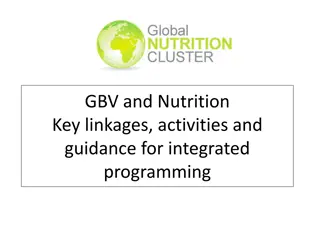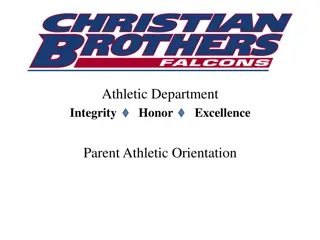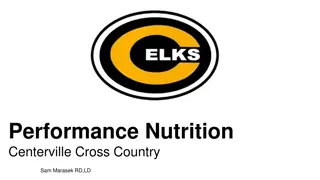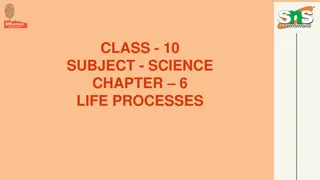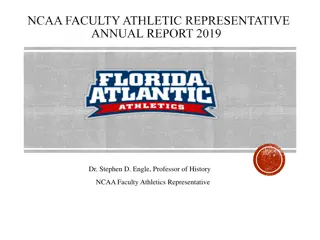Understanding the Impact of Nutrition on Athletic Performance
Sports nutrition plays a crucial role in optimizing performance and overall well-being for athletes. The right balance of nutrients before, during, and after exercise is essential for energy, recovery, and immune support. Positive energy balance promotes weight gain, while negative balance can lead to weight loss and other health issues. Nutrient-rich diets and proper hydration are key for sustained performance and injury prevention in athletes.
Download Presentation

Please find below an Image/Link to download the presentation.
The content on the website is provided AS IS for your information and personal use only. It may not be sold, licensed, or shared on other websites without obtaining consent from the author. Download presentation by click this link. If you encounter any issues during the download, it is possible that the publisher has removed the file from their server.
E N D
Presentation Transcript
CHAAPTER ONE CHAAPTER ONE Introduction to Sports Nutrition
The importance of an adequate diet for athletes The nutritional composition and adequacy impact on performance and overall well- being. of an athlete s diet has an The consumption of food and during and after training and competition, can affect the athlete s nutritional and immune status, health, body mass and composition, energy stores and nutrient availability, exercise recovery. fluid as fuel and hydration, before, performance and
Participation in all types of exercise, ranging from recreational exercise to competitive sport increases the physical demands on the body. Their in- creased energy expenditure requires athletes to consume higher energy in- takes and specific amounts of nutrients from food and fluids, in the pursuit of meeting the demands of sport and exercise. Therefore, an important goal of an adequate diet for athletes is achieving and maintaining energy balance, which aims to restore energy reserves and leads to greater fulfilment of health and performance goals. While positive energy balance (when energy intake is higher than energy expenditure) encourages weight gain, negative energy balance (when energy intake is lower than energy expen- diture) can result in weight loss.
However, there are consequences to both positive and negative energy balance that need to be considered in the long term. Positive energy balance may lead to over-fatness and chronic illness, and negative energy balance may result in an increased risk of muscle tis- sue loss, fatigue, injury and illness. An adequate diet involves more than just energy balance, as key nutrients and fluid replacement have a role in preparation, support and enhancement of the athlete s exercise and sports performance. An adequate sports diet also prevents some negative effects associated with prolonged exercise, such as nutrient fatigue.
The nutrients, namely, carbohydrates, proteins and fats provide energy for exercising muscles. The proportion of these nutrients required are dependent on factors such as the athlete s body weight, age, gender, intensity and duration of exercise and timing of meals (i.e. eating before, competition). during and after training or While many athletes believe they are eating a high-carbohydrate, low-fat eating plan, on closer inspection or analysis of the diet it is often revealed that the diet is in fact a high-fat, low-carbohydrate plan, different to the average western diet. Participation in exercise may also increase the need for certain vitamins and minerals, those that have specific functions in exercise metabolism and the immune system. and not much
All athletes start out with recreational exercise. Some may continue this level of exercise participation indefinitely. However, for many athletes, participation in sport can become highly competitive and this environment requires that athletes train and compete at their maximum capacity. The need for an adequate sports diet can help athletes sustain strenuous activities that may be of varying intensity, duration, frequency and skill. To help an athlete achieve an adequate sports diet, the goals set out in the following text can be applied to all athletes participating at any level of sport. These goals form the foundation of the athlete s everyday diet, which can then be tailored to suit the individual needs of an athlete as their demand for food and fluid change through various stages of training, competition and recovery
Goals of an adequate sports diet Goals of an adequate sports diet To follow the basic healthy eating guidelines To meet energy and nutrient requirements To maintain health and well-being in both short term and long term To reach and maintain a healthy body mass, appropriate body composition levels, including body fat and body muscle tissue, and body water, as well as other health indices (i.e. waist circumference). To plan and implement training and competition nutrition strategies To ensure optimal hydration before, during and after exercise To treat suboptimal nutrient levels and any known nutritional deficien- cies To treat and manage any ailments or diseases (i.e. diabetes) while eating for sport To determine if or when nutritional supplements may be of benefit to the diet and exercise performance
General training goals are listed below: Improving performance Improving specific components of fitness Avoiding injury and overtraining Achieving top performance for selected events (i.e., peaking) Long-term nutrition goals are formulated to support training, provide adequate recovery, maintain the immune system, and support overall health. Athletes who train hard deplete nutrient stores and are at risk for frequent and repeated infections. Short term nutrition goals are often focused on specific strategies for nutritional intake prior to and during competition.
Long Long- -term sports nutrition goals: term sports nutrition goals: Adequate energy intake to meet the energy demands of training Adequate replenishment of muscle and liver glycogen with dietary carbohydrates Adequate protein intake for growth and repair of tissue, particularly muscle Adequate overall diet (e.g., proteins, antioxidant vitamins) to maintain a healthy immune system Adequate hydration Short-term sports nutrition goals: Consumption of food and beverages to delay fatigue during training and competition Minimization of dehydration and hypohydration during exercise Utilization of dietary strategies known to be beneficial for performance, such as pre- competition meal, caffeine intake, or carbohydrate loading
Barriers to achieving an adequate sports diet and Barriers to achieving an adequate sports diet and best food practice best food practice Although athletes are constantly seeking ways to improve exercise performance, there may be a number of reasons that may prevent athletes from choosing or adhering to an adequate sports diet or adjusting their dietary behaviour to achieve optimum performance. The following will be discussed in the subsequent text: Athletes source of information (i.e. the media) and misconceptions about optimal sports nutrition practices Poor nutrition knowledge Dietary extremism Poor practical food skills Frequent travel
Athletes primary source of information and Athletes primary source of information and misconceptions misconceptions There is a plethora of information available through the media, and surveys on athletes have found that many athletes rely on the media as the primary source of nutrition information (Jacobson and Aldana, 1992). Thus at the time, TV, commercials, magazines, advertisements, books, popular magazines and newspapers appeared to be a source of nutritional in- formation for athletes. Another media forum, the Internet, has become accessible and affordable to athletes. Various social networking websites allow users information by chat-room forums, email and instant messaging, some allowing content to be distributed in real-time uploaded. to exchange as it is
Poor nutrition knowledge Since knowledge, attitudes and beliefs may act to encourage or discourage behaviour change (Thompson and Byers, 1994; Main and Wise, 2002), lack of knowledge about sports nutrition may be a barrier for athletes who wish to follow an adequate sports diet and make favorable dietary choices. It seems that while some athletes may perceive themselves to have an understanding of nutrition for athletes, their perception may not match their performance in a knowledge survey. With the rise in over-drinking during exercise, a recent survey examined how physiology drive drinking behaviours in runners . Winger et al (2011) found that most runners relied on personal experience of trial and error as a factor influencing their drinking behaviour. However, the survey revealed this group of athletes inadequate understanding of physiological principles underlying hydration practices, putting them at risk over- hydration and its consequences. beliefs about hydration and
Some athletes may have a general nutrition knowledge base, but fair poorly when asked questions specifically about the diet for athletes. Most athletes in recent surveys have been unable to identify the role of sport- specific nutrients such as carbohydrates and its role in exercise and/or proteins as a fuel for exercise. The latter misconception, that protein is a primary source of energy for muscle contraction, is a common finding among athletes surveyed It is, therefore, not surprising when athletes regard protein supplementation as necessary for exercise performance
Not all athletes have poor nutrition knowledge, as certain groups of athletes appear to have a higher level of knowledge in nutrition. Apart national level, scored higher on nutrition-related multiple-choice, general knowledge and sport-specific questions than their age-matched non-athletes from having a few misconceptions, elite athletes competing at Similarly, Raymond-Barker et al (2007) found that competitive endurance athletes level of knowledge of general nutrition was significantly higher than non-athletes of the same age group and gender.
What knowledge would benefit athletes? What knowledge would benefit athletes? Athletes need to understand the concepts in energy and fluid balance. In general these include, but are not exclusively: energy and its terms, i.e. kilocalorie, kilojoule; their individual energy expenditure and energy intake, and the relation- ship between dietary intake and physical performance; the nutrient water and the fine balance between dehydration and over- hydration in sport and the consequences; the nutrient alcohol and its impact on sports performance and recovery; vitamins, minerals, dietary allowances and their role in health and exercise; and antioxidants, muscle soreness and requirements for athletes of various sports.
Athletes may not be able to practically apply their nutrition knowledge to make favorable food choices, due to the following reasons: Some may have a misunderstanding of food groups Other studies have also shown that knowledge, or know what advisable eating behavior is, favorable dietary practices may not be applied An inability to understand the profile of foods within food groups, i.e. those foods within one food group have a similar, not identical nutrient make-up An inability to read food labels and choose the most appropriate pack- aged food or supplement as part of an adequate sports diet while athletes may have the
Athletes may not be able to convert scientific sports nutrition principles into achievable dietary practices because they do not know: about their body weight loss (through sweat) or gain (through over- drinking) during exercise and its performance; about ergogenic aids (performance-enhancing aids) and its uses; about pre-, during and post-competition nutrition strategies; about sport-specific nutritional needs, i.e. fluid strategies to use in endurance sports. impact on their health and
Dietary extremism Athletes who have misconceptions about nutrition and sports performance may be trapped by dietary extremism, which can limit the variety of foods they consume in their diet. Dietary extremism includes the following: Obsessive behavior around food Disordered eating, i.e. food restriction, binge eating Excessive use of supplements, either nutritional or ergogenic aids Consuming very low (calorie) energy diets leading to underweight and low body fat levels Very low-fat diets Exclusion of one or more food groups Regularly skipping meals
Basic Sports Nutrition Standard and Guidelines Basic Sports Nutrition Standard and Guidelines Sports nutrition principles are based on sound general nutrition principles that have been modified to reflect the demands of training and competition. General guidelines help all people, including athletes, to achieve optimal nutritional health. An optimal diet is one in which there are neither deficiencies nor excesses
The early focus of nutrition research was on the amount and type of nutrients needed to prevent deficiencies. Once nutrient deficiency diseases were well understood the research focus changed to the amount and type of nutrients that help prevent chronic diseases. A chronic disease is one that progresses slowly, such as heart disease or osteoporosis (i.e., loss of bone mineral density). These diseases are a reflection of long-term, not short-term, nutrient intake. Keeping in mind the need to prevent nutrient deficiencies as well as nutrient excesses, guidelines have been macronutrients (i.e., carbohydrates, proteins, and fats), fiber, vitamins, minerals, electrolytes (e.g., sodium, potassium), and water. These guidelines are known as the Dietary Reference Intakes established for energy (calories),
Dietary Reference Intakes (DRI). The Dietary Reference Intakes (DRI) is a standard used to assess and plan diets for individuals and groups (Institute of Medicine, 2006 and 2001). The DRI expands on and replaces the 1989 Recommended Dietary Allowances (RDA) and the Recommended Nutrient Intakes (RNI) of Canada. The DRI is a general term that includes four types of reference values Recommended Dietary Allowances, Adequate Intake, Estimated Average Requirement and Tolerable Upper Intake Level
The DRI are based on the Recommended Dietary Allowance whenever possible (i.e., when enough research has been conducted). When an RDA cannot be determined, the Adequate Intake (AI) becomes the reference value for the DRI. The AI is not as scientifically strong since it is based on estimates or approximations derived from scientific research. The Dietary Reference Intakes and the reference value used for each vitamin and mineral are found on the inside gatefold of this textbook. The use of the term RDA has caused some confusion. For many years, the RDA was the standard, but now is one of the reference values used to compile the DRI, the current standard.
Athletes in training may wonder how the DRI apply to them since they were developed for the general population. Since the goal of the DRI is to guard against both nutrient inadequacies and excesses, athletes use the DRI to assess the adequacy of their current diets and to plan nutritious diets. For example, there is little evidence that athletes need vitamins and minerals in amounts greater than the DRI (Volpe, 2005). On the other hand, some of the DRI, such as the estimated energy requirement or the need for water intake, may not be appropriate to use with athletes in training because athletes energy and fluid needs may be greater than those of the general population. In such cases other standards and guidelines are used.
Most of the dietary recommendations do apply, such as getting adequate nutrients within calorie needs and eating fiber-rich fruits, vegetables, and whole grains to meet carbohydrate needs. But some of the recommendations may not apply. For example, for those athletes who lose large amounts of sodium in sweat, limiting sodium intake to 2,300 mg daily may be detrimental. Athletes engaged in regular training will usually easily meet and exceed the physical activity recommendations contained in the Dietary Guidelines. However, some athletes concentrating on sports involving very specific components of fitness
(e.g., muscular strength for weight lifting or bodybuilding) may need to be conscious of including other components of fitness (e.g., cardiovascular exercise) necessary for long-term health. The Dietary Guidelines are a good starting point for people who want to improve their health and fitness. The general nutrition principles can then be modified to fit the demands of training
Atrophy: A wasting or decrease in organ or tissue size. Macronutrient: Any essential nutrient needed in large quantities (e.g., carbohydrates, proteins, and fats). Fiber: A component of food that resists digestion (e.g., pectin, cellulose). Electrolyte: A substance in solution that conducts an electrical current (e.g., sodium, potassium). Dietary Reference Intakes (DRI): Standard for essential nutrients and other components of food needed by a healthy individual.
Adequate Nutrients within Calorie Needs Consume a variety of nutrient-dense foods and beverages within and among the basic food groups while choosing foods that limit the intake of saturated and trans fats, cholesterol, added sugars, salt, and alcohol. Weight Management To maintain body weight in a healthy range, balance calories from foods and beverages with calories expended. To prevent gradual weight gain over time, make small decreases in food and beverage calories and increase physical activity.
Food Groups to Encourage Consume a sufficient amount of fruits and vegetables while staying within energy needs. Two cups of fruit and 2 cups of vegetables per day are recommended for a reference 2,000-calorie intake, with higher or lower amounts depending on the calorie level. Choose a variety of fruits and vegetables each day. In particular, select from all five vegetable subgroups (dark green, orange, legumes, starchy vegetables, and other vegetables) several times a week. Consume three or more ounce-equivalents of whole-grain products per day, with the rest of the recommended grains coming from enriched or whole- grain products. In general, at least half the grains should come from whole grains. Consume 3 cups per day of fat-free or low-fat milk or equivalent milk products.
Fats Consume less than 10% of calories from saturated fatty acids and less than 300 mg/day of cholesterol, and keep trans fatty acid consumption as low as possible. Keep total fat intake between 20 to 35% of calories, with most fats coming from sources of polyunsaturated and monounsaturated fatty acids, such as fish, nuts, and vegetable oils. When selecting and preparing meat, poultry, dry beans, and milk or milk products, make choices that are lean, low fat, or fat free. Limit intake of fats and oils high in saturated and/or trans fatty acids, and choose products low in such fats and oils.
Carbohydrates Choose fiber-rich fruits, vegetables, and whole grains often. Choose and prepare foods and beverages with little added sugars or caloric sweeteners, Reduce the incidence of dental caries by practicing good oral hygiene and consuming sugar- and starch containing foods and beverages less frequently. Sodium and Potassium Consume less than 2,300 mg (approximately 1 tsp of salt) of sodium per day. Choose and prepare foods with little salt. At the same time, consume potassium-rich foods, such as fruits and vegetables
Alcoholic Beverages Those who choose to drink alcoholic beverages should do so sensibly and in moderation defined as the consumption of up to one drink per day for women and up to two drinks per day for men. Alcoholic beverage should not be consumed by some individuals, including those who cannot restrict their alcohol intake, women of childbearing age who may become pregnant, pregnant and lactating women, children and adolescents, individuals taking medications that can interact with alcohol, and those with specific medical conditions. Alcoholic beverages should be avoided by individuals engaging in activities that require attention, skill, or coordination, such as driving or operating machinery
Food Safety To avoid microbial foodborne illness: Clean hands, food contact surfaces, and fruits and vegetables. Meat and poultry should not be washed or rinsed. Separate raw, cooked, and ready-to-eat foods while shopping, preparing, or storing foods. Cook foods to a safe temperature to kill microorganisms. Chill (refrigerate) perishable food promptly and defrost foods properly. Avoid raw (unpasteurized) milk or any products made from unpasteurized milk, raw or partially cooked eggs, or foods containing raw eggs, raw or undercooked meat and poultry, unpasteurized juices, and raw sprouts.
Basic Sports Nutrition Guidelines Basic Sports Nutrition Guidelines Sports nutrition recommendations build upon and refi ne basic nutrition guidelines. Athletes need to understand and apply general nutrition principles before making modifications to reflect their training and sport specific nutrient demands. Ultimately, sports nutrition recommendations are fi ne-tuned and are as precise as possible to closely meet the demands of training and competition and reflect the needs of the individual athlete. Here is a brief overview of some key sports nutrition recommendations (American Dietetic Association et al., 2000; Burke et al., 2001).
Energy: An adequate amount of energy is needed to support training. Appropriate amounts of food should be consumed daily to avoid long-term energy deficits or excesses. Adjustments to energy intake for the purpose of attaining a body weight or body composition goal should be made slowly and started early enough in the training mesocycle so as not to interfere with training or performance
Carbohydrates: An intake of 5 to 10 grams (g) of carbohydrates per kilogram (kg) of body weight per day is recommended. The daily amount needed depends on the sport, type of training, gender, and need for carbohydrate loading. Timing is also important and recommendations for carbohydrate intake before, during, and after exercise are made. The use of the glycemic index (GI) may assist athletes in fi ne-tuning their carbohydrate intake
Proteins: An intake of 1.2 to 1.7 g of protein per kg of body weight per day is generally recommended. This recommendation assumes that energy intake is adequate. The daily amount of proteins needed depends on the sport and type of training. Timing of protein intake is also important. For example, post-exercise protein ingestion aids in muscle protein resynthesis
Fats: After determining carbohydrate and protein needs, the remainder of the energy intake is typically from fats, although adult athletes may include a small amount of alcohol. Trained athletes generally consume 1.0 to 2.0 g of fat per kg of body weight per day (Seebohar, 2005). Extremely low-fat diets can be detrimental to health and performance. Vitamins and minerals: Athletes should meet the DRI for all vitamins and minerals. The DRI can be met if energy intake is adequate and foods consumed are nutrient dense (i.e., abundant nutrients in relation to caloric content). Any recommendation for vitamin or mineral supplementation should be based on an analysis of the athlete s usual diet.
Fluid: Athletes should balance fluid intake with fluid loss. A number of factors must be considered, including the sweat rate of the athlete and environmental conditions such as temperature, humidity, and altitude. In addition to the above recommendations, there are a number of other critical areas that involve diet. Attaining and maintaining a body composition that enhances performance is important. Some athletes focus on scale weight since weight may be a sport participation criterion, but attaining a particular weight should be done in a healthy manner. Disordered eating (i.e., abnormal eating patterns) and eating disorders, such as anorexia or bulimia, are concerns for individual athletes as well as teammates, coaches, parents, and anyone else who works with athletes.
Athletes need a tremendous amount of information about dietary supplements, since the decision to use them should be based on safety, effectiveness, potency, purity, legality, and ethics. Proper food and beverage intake before, during, and after exercise can enhance training and performance while improper intake can be detrimental. All of these issues are covered in depth in the chapters of this text. With so many details to consider, some athletes find that they begin to follow a rigid daily diet. The key is to meet nutrient needs and support training and performance while maintaining dietary flexibility. Athletes need to keep their diet in perspective: Food is needed to fuel the body
Adhering to a very rigid eating plan can lead to social isolation and can be a sign of compulsive behavior, both of which can create problems for athletes. Some find themselves eating the same foods every day and the joy of eating is diminished. The key is to have a flexible eating plan that is nutritious and includes a variety of foods. Flexibility usually results in short-term over- and under-eating, but long- term weight stability, proper nutrition, and enjoyment of eating. Flexible eating is not the same as unplanned eating. Sports nutrition is complicated and the failure to plan a nutritious diet often results in poor nutrient intake, which may hamper performance and undermine long term health. But eating according to a rigid schedule is a problem, too. Food is for fuel and fun, and athletes must find the right balance.






